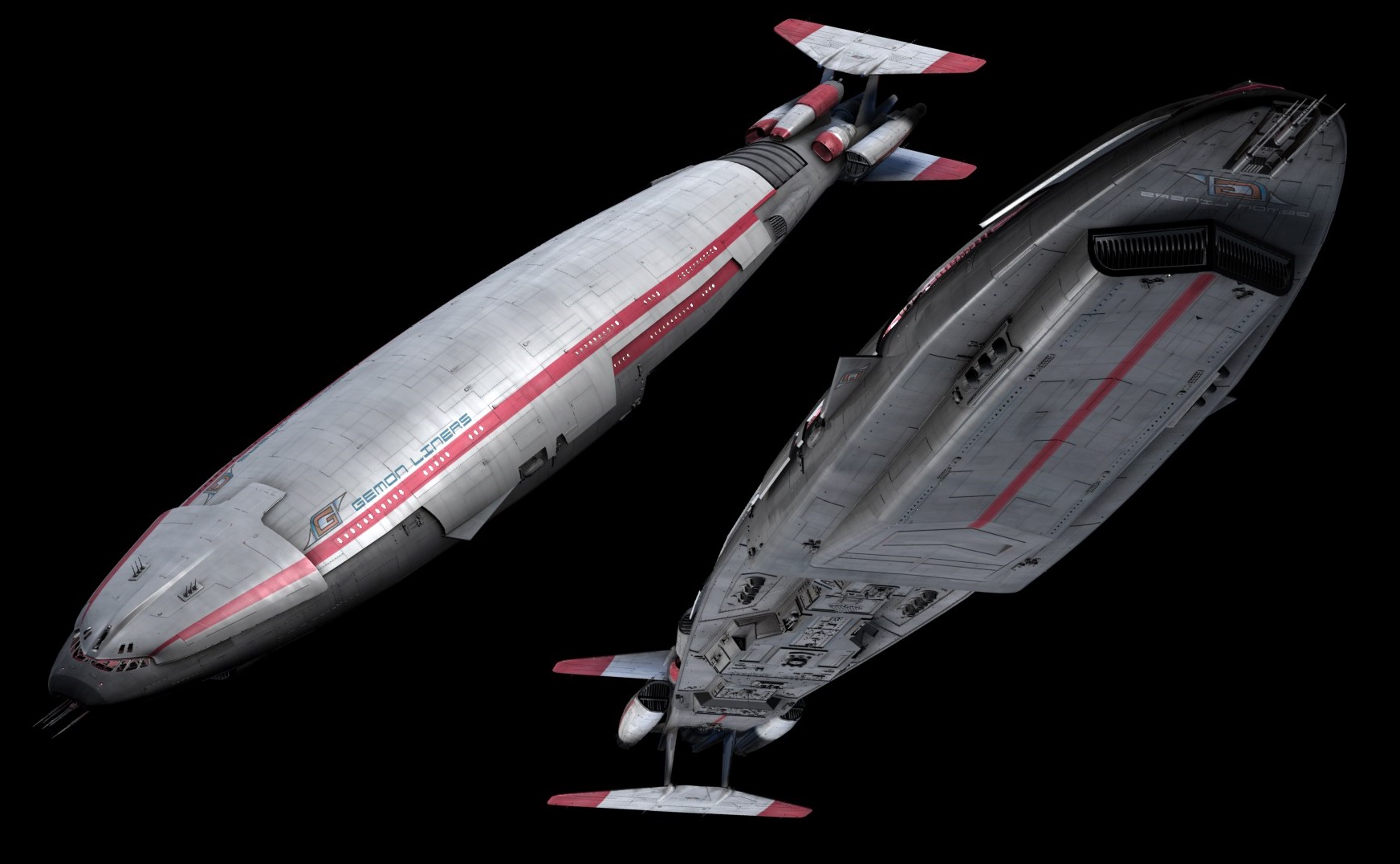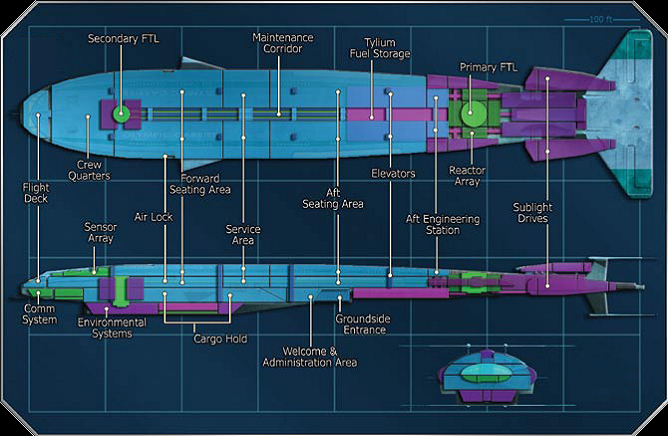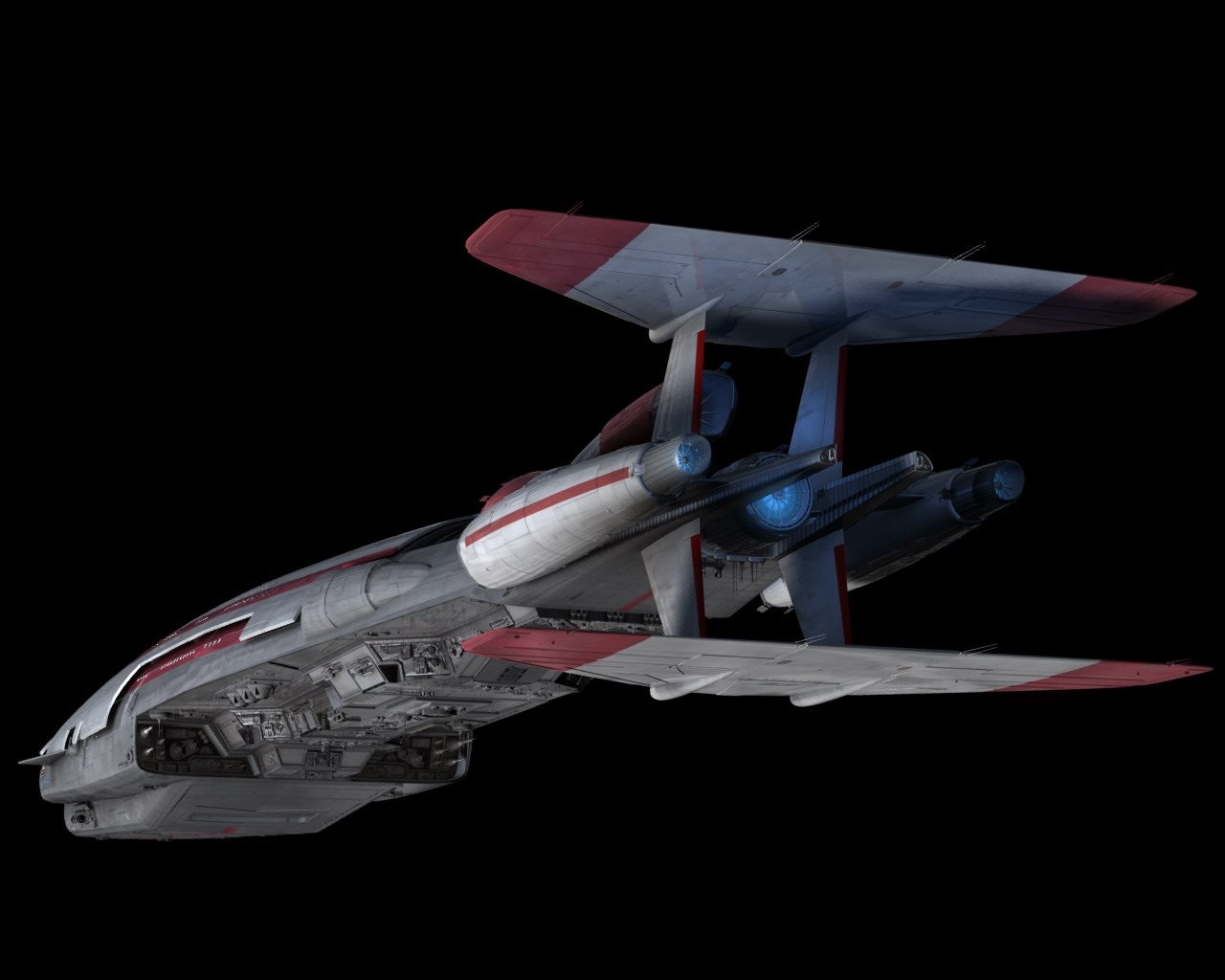
Kobolese Confederation. | Gemenon Industries Traveler-Class Space Liner. | 
Kobolese Confederation. |
|---|
| Gemenon Industries Traveller-Class Space Liner. |
|---|
 | | Dorsal Port Bow And Ventral Starboard Bow Aspect. |
|---|
| State: | Kobolese Confederation. |
|---|
| Type: | Civilian. |
|---|
| FTL: | Trans-warp Space Fold System equipped. |
|---|
| Capacity: | Approx. 1,500, depending on configuration. |
|---|
| Role: | Inter-planetary passenger liner. |
|---|
| Specification: |
|---|
| Length: | 825 feet (251.5m). |
|---|
| Beam: | 130 feet (39.7m). |
|---|
| Clearance: | 75 feet (22.9m). |
|---|
| Wingspan: | 20 feet (optional attachment kit). |
|---|
| Propulsion: | Sublight engines: 4;Commercial-rated FTL drive pods: 2;Maneuvering thrusters: 20. |
|---|
| Crew: | Command Crew: 10.Courtesy Crew: Up to 100. |
|---|
| Weapons: | Pre-Advent:
Typically none. |
|---|
Post-Advent:
6-12 small anti-missile/meteorite batteries. | | Defenses: | Hardened circuitry;Standard civilian shields;Sand casters. |
|---|
| Aero-Spacecraft: | None. |
|---|
 | | Traveler-Class Blueprint View. |
|---|
The Gemenon Industries Traveller-Class Luxury Liners are a series of popular passenger craft that were employed by various operators in the Kobolese Confederation (formerly the Kobolese Royal Empire) since the time of the Twelve Colonies. They were originally produced exclusively by Gemenon Industries, however over time licenses were issued to other firms to produce the ships (though to Gemenon Industries' exacting specifications, rather than mere "knock offs"), With a length of 825 feet, they can comfortably accommodate 1,000 passengers in style and luxury on journeys between planets and even systems. Though rarely used in such a configuration, a significantly cramps 2,500 variant is possible for short-duration (intra-system and even orbital) flights. A commercial passenger ship, it has no weapons and very defense capabilities standard, although some have been retro-fitted with limited weapons (mostly as pirate or militry variants).A more routine configuration includes dividing up the main hull into compartments as passenger berthing, each with an independent head. 2-4 racks and a desk are included, and meal service is usually part of the ticket price (though most offer a bar and some split berthing and meal service, as the ships can carry multiple galleys). Few if any offer much in the way of recreational services; Like it or not, these ships are primarily intended as basic transport, not luxury liners.Design and Capabilities.Liners of this design share a unique fish-like design that make them well suited for interplanetary and inter-atmospheric travel, a common occurrence as these ships arrived at and departed from their destinations. The Pilot House is located at the bow, with the passenger seating in the middle, and aft compartments that hold the ship's four sublight boosters, with the FTL drive in a pair of compartments along the keel of the craft (1 to the bow, one aft). In the standard configurations, these ships can hold up to fifteen hundred people or as few as six hundred.Historic Significance.At the time of the Exodus of Kobol (detailed in "The Sacred Scrolls"), many of these ships became stranded in the space lanes surrounding Kobol. They attempt to gather, but were found and attacked; It is estimated that 1 in 10 escaped. The rest seem to have survive the harrowing multi-year journey fairly unscathed. One was a derelict on Scorpia, which had long-been considered a semi-religious site, around which a hall covering 10 acres had been built. Her name was lost to antiquity, and it was quite clear she crash-landed; Massive crumpling of her ventral side and the clearly cracked nature of her #1 Lateral Dorsal Frame showed how hard she'd landed (though it's possible her crew and passengers survived, since much of the furniture was, in fact, intact 5,000 years later). This is the oldest known ship still in existence in the Kobolese Confederation, and is considered a historic site; Commoners are not permitted to board her, only scientists, researchers, and others with a direct purpose to board are allowed (she's also not particularly safe to board; many would be historians have been injured, and a few even killed, in mishaps on board due to her age). Still, most Kobolese make a pilgrimage to the ship at least once in their lifetime, a process aided now by a Royal Kobolese grant to this purpose.UGC Usage.The UGC in general make quite a bit of usage of this fairly simple, rustic yet reliable frame. The Marine uses them extensively for unopposed landings, and even Special Battalions used two during the Scitsal operation (as a ruse to get on-world WITHOUT raising alarm) under the direction of La L'egion and the Swiss Custodes. They are used far wider than that even, and almost all UGC agencies have a small fleet of these ships, as well as many private concerns. While they are not independently inter-galactically capable, they are more than capable of intra-galactic travel without support. There is also a cargo-only variant capable of up to 100,000 tons of cargo. They are NOT rated for dangerous cargos, but can carry just about anything else; The TTA-flagged Agua is a common sight over many systems in the Milky Way Galaxy, carrying fresh water obtained from many sources to drier systems (including RTF-44371). Note: Under UGC law, all spacecraft capable of independent inter-stellar flight or of accommodating 2 or more passengers MUST be at least minimally armed.Strategic Implications.In a not uncommon deal with Geminon Industries, the UGC bought the patents to the Traveler-Class on a 30/70 split to license outside the Kobolese Confederacy to advance the design; It's simple design and versatility have proven the ships to be real workhorses throughout the UGC in situations where heavier designs are either impossible/impracticable or simply not preferable, which in turn advances the UGC's interests, especially in trade. However, Geminon Industries has never been happy with the deal (despite being the senior partner in the deal), as they felt they were "strong armed" into signing (in fact they were). Nevertheless, there is no UGC allied system that doesn't now have at least a few of these ships running around ferrying passengers and cargo, and many more nearby available in the event of a situation; When a Beorge Cube was sighted enroute to a Brunali settlement, over 5,000 of these ships were called in to evacuate the planets; Not a single civilian was present when the Cube arrived, and they had to settle for what little industrial facilities remained. (Amongst those facilities were many hundreds of booby-traps, most cunningly concealed to allow them to be taken onboard the ships before they tripped, killing an estimated 1/3 of the cube's crew.)Available Modifications.Along with highly flexible cargo configurations, there is a wing assembly available that increases aerodynamic stability, making in-atmosphere flight easier. This is typically only used on the 2,500-ish passenger variant for in-atmosphere or surface-to-orbit shuttle service.UGC owned ships are usually armed, especially militry ships, at minimum with medium lasers (akin to door guns) to protect troops during landings; Although typically used either for follow-on or other uncontested landings, there are usually a few enemies in the area ready to cause the landing some trouble, and always a potential for this, and as such the weapons are installed.Government: United Galaxies Council/Kobolese Confederation.Primary Users: Private, for-profit cruise corporations.Ship Type: Medium/Long Distance Liners.
Class: Traveler-Class.Crew: 110;Command Crew: 1,000.Courtesy Crew: Up to 100.Passengers: 600- 1,500, depending on configuration; 2,500 max.MDC BY LOCATION: |
* Hull
Projectile Shield (Closed)
Small Airlocks/Access Hatches (8)
Outer Hull (per 40ft area) | 15,000
10,000
250 each
200 | Connection Joint/Engineering Section
*** Main Engines/Power Plant (4)
**** Pin Point Barriers (4)
| 1,000
25,000
50,000
|
| NOTES:* Depleting the MDC of the hull will essentially destroy the vessel. All internal systems will shut down, including life support and internal gravity. The ship itself will be an unsalvageable floating wreck, and any surviving passengers must be rescued quickly or will die from asphyxiation as the remaining atmosphere drains into space.*** Depleting the MDC of the main engines will force the ship to rely on its auxiliary engines. Depleting the MDC of the main engines AND auxiliary engines will leave the ship adrift in space. If in an atmosphere, the colony will crash (destruction of the main engines will render the antigravity system useless due to loss of power).**** The Pinpoint Barriers regenerate at a rate of 1,250 MD per second (2,500 MD per melee round). If destroyed, a barrier will completely regenerate within four seconds (2 melee rounds). See the Pinpoint Barrier System entry for details.Speed and Statistical Data: |
Speed (sublight): 0.16 speed of light (25,600 miles per second).
Speed (Auxiliary Drives): Mach 1.
FTL: Range Unlimited (1 light year every 6 minutes).
Planet Bound: Top speed is Mach 1. The Traveler-Class very much IS designed to land on the ground.
Maximum Range: Unlimited (estimated 30 year life span).
Length: 825 feet (251.5m).
Beam: 130 feet (39.7m). | Clearance: 75 feet (22.9m).
Wingspan: 20 feet (optional attachment kit).
Weight: Approximately 1,000,000 tons standard.
Power System: Kobolese-designed Trillium Reactor.
Gravity Control System: Internal.
Cost and Availability: 20 millioncredit; Takes about 02 months to build and outfit.
|
| Weapons Systems: |
1. Pinpoint Barrier Defense System: Originally developed by researchers onboard the SDF-01 MACROSS during the First Robotech War, the Pinpoint Barrier System is a standard defense system on board all UGC starships and colony vessels; The Traveler-Class was not originally outfitted with any defensive systems, but the design was upgraded to include them. The system generates four small disc-shaped force fields that can be positioned anywhere along the ship to deflect missiles, energy beams or projectiles. Each pinpoint barrier is about 200 ft (61 m) in length and can absorb up to 5,000 MD in damage, which then regenerates within four seconds (2 melee rounds). The barriers can also be layered on top of each other to generate a field which provides 20,000 MDC and can even deflect heavy particle beams (usually). The four barriers are controlled by operators in the command tower of the carrier.
Damage Capacity: Can sustain up to 5,000 MD per round. Regenerates at a rate of 2,500 MD per melee round.
Range: Up to 300 feet (91.5 m) from the surface of the vessel.
Radius: 200 feet (61 m).
Attacks Per Melee: Can move from one end of the vessel to the other in less than a single round. Trained operators can attempt to block attacks up to 8 times per melee (counts as a parry) and are at +7 to block. Untrained characters can parry up to their number of hand-to-hand attacks with their normal parry bonuses only.
Payload: Nearly inexhaustible. Will work as long as system is functional (see below) and engines are intact. If main engines are destroyed, the barrier will loose power and not function. Note: If all four barriers are grouped in a single spot they can deflect a heavy particle beam attack, such as the one generated by the Macross Cannon, Tśentrædi, and some others. However, the beam will completely destroy all four barriers and put incredible strain on the pinpoint barrier system, to the point where it may short out. After deflecting an energy beam, roll percentile dice on the table below to determine additional effects/damage.01-15: Lucked out, system will be operational in 1D6 hours.16-30: Minor damage, system will require 4D6 hours to repair.31-45: Major damage, system will require 2D6 times 10 hours to repair (yes, DAYS of work).46-60: Completely destroyed! System can be rebuilt, but will require new parts and 2D6 DAYS of work to replace.61-75: Major damage, system will require 2D6 times 10 hours to repair.76-90: Minor damage, system will require 4D6 hours to repair.91-95: Lucked out, system will be operational in 1D6 hours.96-00: It's a miracle! Trivial damage only, system will be operational again in only 4D6 melee rounds! | 2. Six 20MM Vulcan Cannon: Controlled by Gunners and located on both sides, these are used on militry Traveler-Class liners for landings. They don't 'usually' get used, but they have been.
Effective Range: 4,000 feet (1,220 m).
Mega Damage: 1D6 times 10 for a burst of 30 round, 2D4 for each round.
Rate of Fire: Equal to the combined hand to hand attacks of the gunner (usually 4 or 5).
Payload: 3000 rounds (100 bursts) each. |
 |
| Port Astern Ventral Aspect. |
|---|
| Features: |
- ESM: Radar Detector. Passively detects other radars being operated.
- Radar: Combat grade radar. Range 100 miles, can track up to 50 individual targets. 95% reliability (00% against unfriendly stealthed vehicles).
- GPS: Standard tracking device. Ties into the Blue Force Tracker.
- HUD: Displays maps, radar, targeting information, and any OTHER information the wearer wants directly in front of the user.
- Virtual Map: Displays a continuously-updating map of local terrain for the pilot. Takes data from and gives data to other friendly units in the area. Effective navigation of 85% as updates come. Good to 500 miles. Specific range can be adjusted in 1 mile increments.
- Loudspeaker: Amplifies voice 1 to 100 times. 100' in normal crowds.
| - Video Camera: Records from the HUD. 50 hours of recording available.
- Full range optic sensory suite: Infrared, ultra violet, Magnification, night sight, color filters, thermal imager. Range is about 200 miles for MOST sensors.
- Escape Spheres: Can hold up to 10 survivors for one week.
- Survival Pack: A pack of simpler emergency survival supplies: Pup tent, sleeping bag, black light, GPS, first aid kit (bandages, gauze, bandage tape, pads, antiseptic/analgesic), plasma torch (for small repairs and starting fires), repair kit (with MDC Repair Spray), sewing kit (a small spool of thread and 5 needles), 7 star flares (250' apogee), 2 white parachute flares (1,500' apogee), 100' of black or brown parachute cord (150 lbs tensile strength), 2-5 days rations, 2 gallons water, water purification kit-good for about 10 gallons.
|
Combat Profile for an average Traveler-Class Liner:- 2 defensive attacks per melee.
- +1 to roll with the punch, strike, and dodge.
- One additional attack at levels 5 and 10.
|




